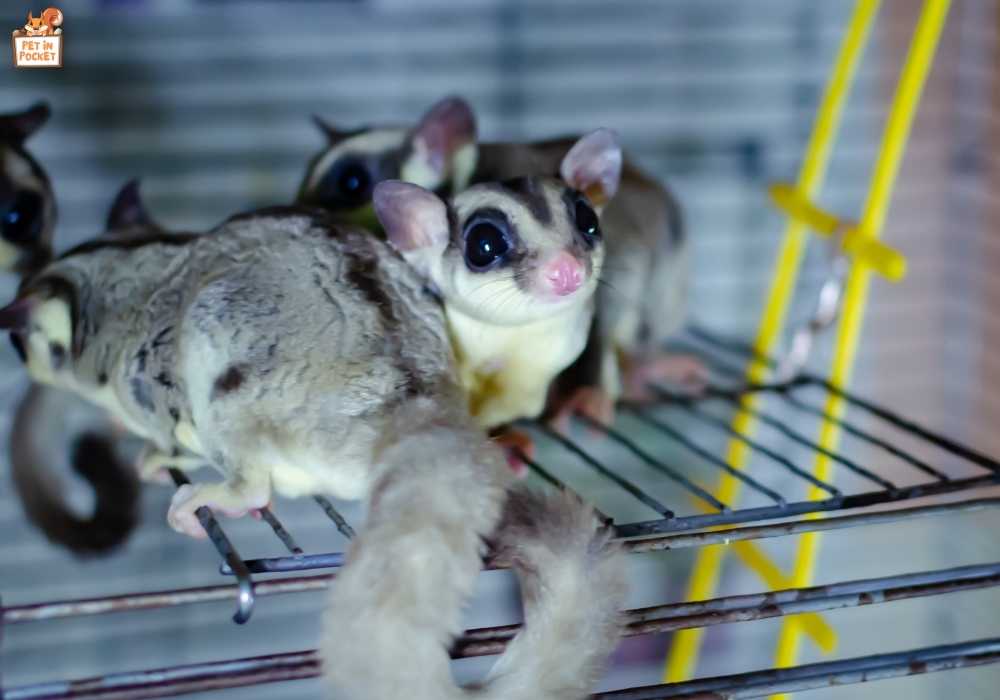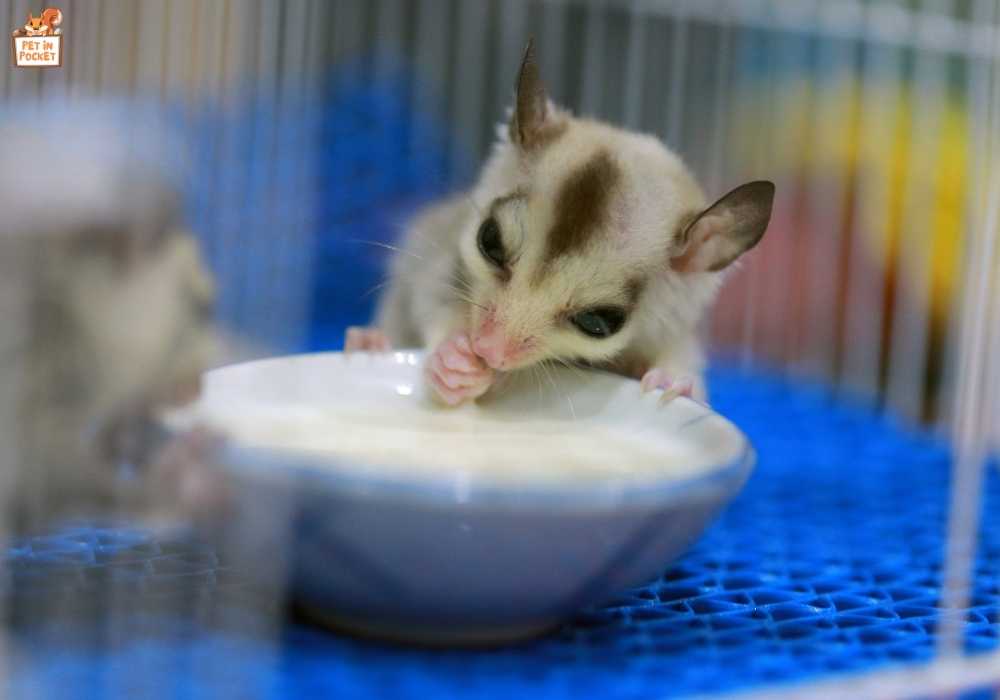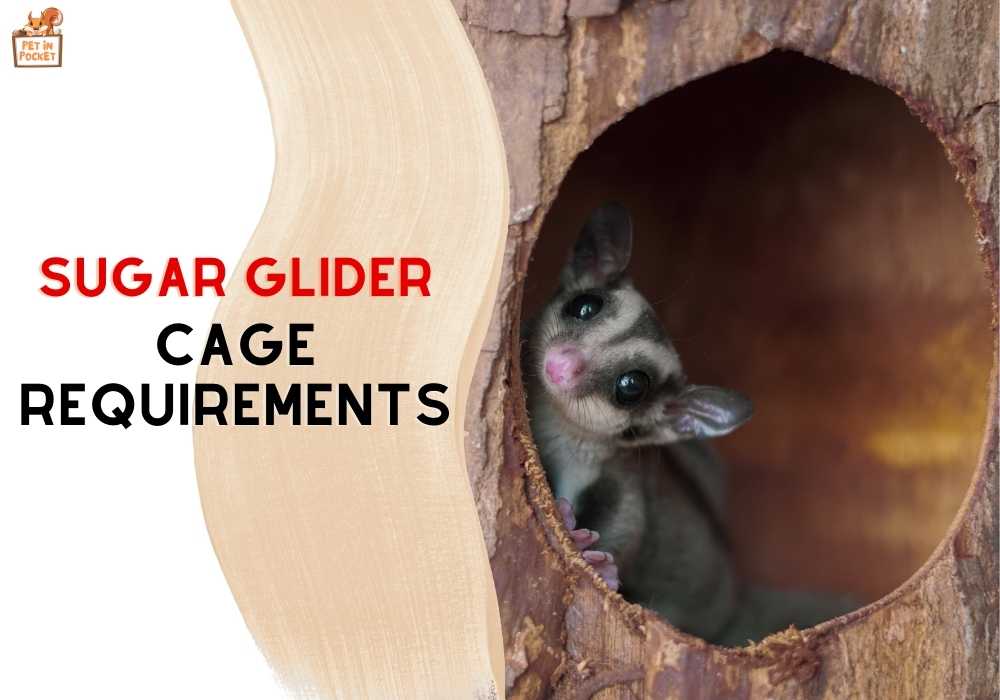Sugar gliders need everything properly in the place where they live. Adding all the requirements properly in their cage will help them to grow up healthy and will keep them in a joyful mind. In this blog sugar glider cage requirements, we will guide you through all the necessary aspects of designing an ideal sugar glider cage. We will start by discussing what makes sugar gliders unique pets, followed by the importance of having a well-designed cage. We will also point out some common mistakes to avoid when setting up your pet’s home. Moving on, we will discuss the components of an ideal sugar glider cage, including sizing, materials, and structure.
Lastly, we will talk about essential add-ons that can make your pet’s life even more comfortable and answer the frequently asked question: do sugar gliders need bedding in their cage? With this comprehensive guide, you’ll be well-equipped to design a safe and happy home for your furry friend.
Table of Contents
Understanding Sugar Gliders: An Overview
As we know sugar gliders are mainly from Australia, and Papua New Guinea, they require proper care and arrangements to grow up properly far from their native place. Their nocturnal nature necessitates a warm and cozy cage in a dimly lit room, away from direct sunlight. It’s crucial to provide a suitable habitat for their well-being. Bonding with these unique pets is essential for their mental and emotional health. For glider owners, understanding the bonding process is the key to nurturing a healthy relationship with their adult sugar gliders or baby sugar glider.
Regular consultations with a veterinarian and following a proper TPG (Time, Place, and Gentle) approach help in ensuring their welfare. Careful attention should be paid to the bars of the cage and the side of the cage to prevent any mishaps, and regular cleaning is necessary to maintain proper sugar glider care and hygiene.
What Makes Sugar Gliders Unique Pets?
Sugar gliders are unique pets due to their gliding abilities. They require enough space in their cages for gliding and vertical bars. Nutrition-wise, fresh fruits, nectar, yogurt, and access to water are essential. Loss of appetite could indicate health issues, so proper care is crucial. Additionally, sugar gliders need bonding pouches, hammocks, and spacious cages with plenty of toys and stimulation.

The Importance of a Proper Cage for Your Sugar Glider
Sugar gliders require adequate housing to simulate their natural habitat while in captivity. To create an ideal environment, it is crucial to provide sufficient space, natural wood, and proper nutrition within the cage. Enrichment accessories such as toys, proper bedding, and fresh fruits must be included to ensure their mental and physical well-being. Narrow bars on the cage are necessary to prevent escape, while pesticides, cedar, or parasites should be avoided. Large cages with good ventilation are recommended, and proper care of the cage’s bottom is essential.
To ensure the best possible living environment for sugar gliders, we should pay close attention to the cage setup. It is also important to consult a veterinarian for guidance on sugar glider care if you are an adult sugar glider owner or have baby sugar gliders. A vet can provide valuable insights into the specific needs of your pets and help you take appropriate measures for their overall health and well-being.
Why a Well-Designed Cage is Essential?
When your pet is sugar gliders, designing their cage is a crucial aspect that can affect their health and happiness. To ensure that your pet thrives in its environment, it is important to take into consideration several factors such as the materials used, size of the cage, vet care and additional features.
Sugar gliders are highly active and social animals that require ample space to climb, glide, and play. The cage should have multiple levels and branches for them to explore and exercise. Additionally, material selection is an important factor when designing the cage as toxic substances or sharp edges can pose a risk to their safety.
It is also essential to establish a relationship with an experienced veterinarian who can provide regular check-ups for your sugar glider. They may suggest certain dietary requirements or supplements necessary for optimal health.
Lastly, incorporating additional features such as hammocks, toys, and hiding spots can help simulate their natural habitat and enrich their lives. A well-designed sugar glider cage can lead to a happy and healthy pet that will bring joy to any household.
Common Mistakes in Cage Setup to Avoid
When you are setting up a cage for sugar gliders, there are certain common mistakes that you must ensure their health and well-being. For example, bird cages and accessories are not appropriate for sugar gliders as they require specialized cage designs and tailored accessories. Additionally, the use of cedar or wood shavings should be avoided as they could cause respiratory issues. The materials used in the construction of the cage, such as PVC and fleece, must be carefully considered, and adequate space and vertical bars should be provided to allow the gliders to thrive. Proper nutrition and veterinary care are also critical factors that cannot be overlooked.
When selecting accessories for the cage, it’s important to exercise caution to ensure the safety and comfort of these adorable marsupials. It’s also advisable to provide plenty of opportunities for exercise, playtime, and interaction with their owners as this can greatly enhance their quality of life.
Components of an Ideal Sugar Glider Cage
We should always remember that an ideal sugar glider cage provides ample space, suitable bars, and proper nutrition for adult sugar gliders. It should be equipped with appropriate bedding, hammocks, and enriching accessories for their well-being, as well as toys, bonding pouches, and vet care essentials. Additionally, the cage must include a water bottle, fruits, and nutritious vet care food to meet their dietary needs. Glider owners must ensure the cage is designed in a way that promotes social bonding and facilitates the gliding behavior of these marsupials. Regular veterinary care, including tpg and poop monitoring, is essential for maintaining the health and well-being of sugar gliders and ensuring their long-term vitality.

Sizing, Materials and Structure: What to look for?
When you are buying a cage for your sugar glider, it is important to consider various factors such as size, materials, and structure. Experts suggest that the cage should be a minimum of 24 inches wide, 24 inches deep, and 36 inches tall if you own one or two sugar gliders. Moreover, the cage should be constructed using safe materials like powder-coated metal or PVC-coated wire.
The structure of the cage should have horizontal bars that allow for climbing and enough space for toys and accessories. This provides your sugar gliders with sufficient opportunities to exercise and play. To prevent any escape attempts by your pets, ensure that the cage has secure latches and doors.
It is important to use soft and absorbent bedding material inside the cage like fleece or paper-based bedding. Avoid using wood shavings or other materials that could harm your pet’s respiratory system. Regular cleaning of the cage is necessary to maintain hygiene and prevent any potential health issues.
Apart from these factors, it is also important to provide adequate lighting inside the cage. Sugar gliders require natural light exposure to maintain their circadian rhythms. Therefore, placing the cage near a window or using full-spectrum lighting can be beneficial for their health.
Finally, creating an enriching environment inside the cage is crucial for keeping your sugar gliders happy and healthy. Providing toys such as ropes, swings, tunnels, and puzzles can keep them mentally stimulated and prevent boredom.
Essential Add-ons in Your Sugar Glider Cage
You can add more things to the cage to ensure the optimal and the best environment for your sugar glider. These add-ons include bonding pouches, hammocks, nutrition, enrichment, and proper vet care.
It is crucial for glider owners to prioritize the inclusion of these items to meet the specific requirements of adult and baby sugar gliders. The placement of these accessories is also crucial to ensure the safety and comfort of the gliders. Here are some dos and don’ts to keep in mind when designing your sugar glider cage:
Dos:
Don’ts
Do Sugar Gliders Need Bedding in Their Cage?
Bedding is a crucial element for the comfort and hygiene of sugar gliders in their cages. It is essential to choose safe materials such as fleece or wooden bedding while avoiding substances that contain pesticides, parasites, or cedar as these can be detrimental to the health of sugar gliders. Apart from selecting the right bedding, maintaining proper nutrition and veterinary care are also critical for their well-being. A balanced diet consisting of fresh fruits and vegetables, protein, and calcium supplements is necessary for their health. Sugar gliders are prone to various health issues like dental problems and obesity; hence, regular check-ups with a veterinarian are crucial to keep them healthy.
To ensure that your sugar glider leads a joyous life, it is important to provide a comfortable environment along with toys and exercise equipment in their cage to help them stay active and entertained. As social animals by nature, giving them plenty of attention and interaction every day can keep them happy and content.
In addition to this, it is vital to maintain cleanliness in their surroundings by regularly cleaning their cages. Proper hygiene helps prevent bacterial growth that can lead to infections or diseases.
By following these guidelines, you will be able to provide your sugar glider with a comfortable and healthy living space that meets all its needs. It will also help establish a strong bond between you and your pet as they thrive under your love and care.
Conclusion and final thoughts
To wrap up, providing a suitable cage for your sugar glider is essential for their well-being and happiness. A well-designed cage not only ensures their safety but also provides them with the necessary space to exercise and play. Avoid common mistakes in cage setup and choose the right size, materials, and structure for the cage. Don’t forget to include essential add-ons like branches, toys, and hiding spots to create a stimulating environment for your pet. While bedding is not necessary, it can provide comfort and help absorb odor. Remember, your sugar glider’s cage is their home, so make sure it meets their needs and allows them to thrive in captivity.
FAQ:
What size cage is suitable for a sugar glider?
A cage that is at least 24 inches high, 24 inches wide, and 36 inches long is recommended for a sugar glider.
Can sugar gliders be kept in pairs?
Yes, sugar gliders are social animals and should be kept in pairs or small groups.
What kind of materials should be used for a sugar glider’s cage?
The cage should be made of safe and non-toxic materials such as powder-coated metal or stainless steel.
Do sugar gliders need bedding in their cage?
While bedding is not necessary, it can provide comfort and help absorb odor.
What kind of toys should be included in a sugar glider’s cage?
Toys that provide enrichment and mental stimulation such as climbing structures, puzzles, and foraging toys should be included in a sugar glider’s cage.






Leave a Reply